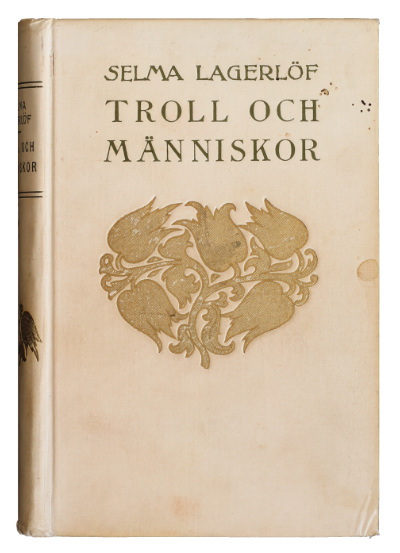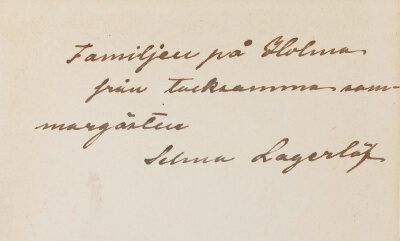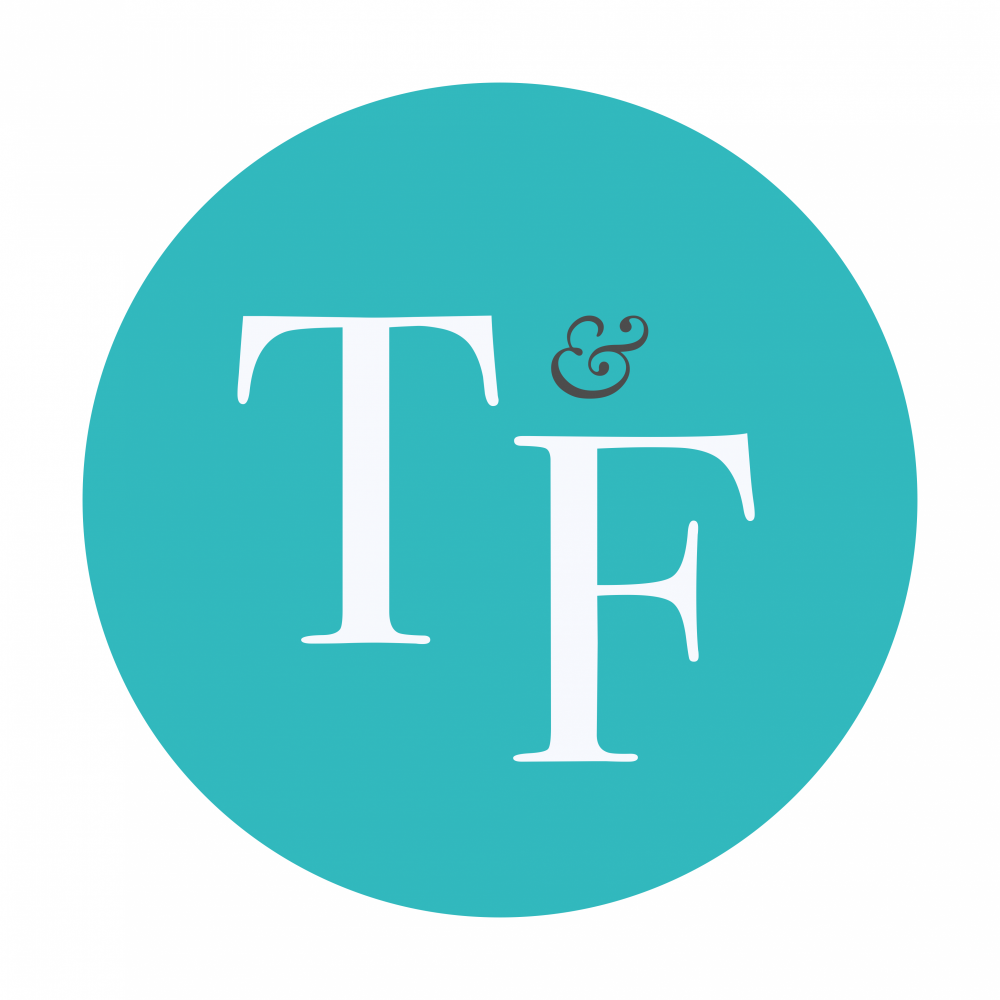A POPULAR SHORT STORY COLLECTION BY NOBEL PRIZE WINNER SELMA LAGERLÖF,
INSCRIBED TO THE PIONEERING OCEANOGRAPHER OTTO PETTERSSON
LAGERLÖF, Selma Ottiliana Lovisa. Troll och människor. Stockholm: Alb. Bonniers Boktryckeri for Albert Bonniers Förlag, 1915.
Octavo (176 x 115mm), pp. 336, [2 (contents, blank)], [2 (blank l.)]. Publisher’s woodcut device on title. (Light marginal marking on pp. 317-323.) Original cream cloth, upper board and spine lettered in green and decorated with central gilt floral design. (Some light marking, extremities slightly rubbed and bumped, small splits on joints, hinges skilfully reinforced.) Provenance: Sven Otto Petterson, Holma, [?]1915 (1848-1941, autograph presentation inscription from Lagerlöf on front free endpaper ‘Familjen på Holma frůn tacksamma sommargästen Selma Lagerlöf’, i.e. ‘The family at Holma from your grateful summer guest Selma Lagerlöf’) – Antikvariat Mats Rehnström, Stockholm (Cyberkatalog 22: Dedikationer, 26 January 2016, no. 40).

First edition, first to tenth thousand. Selma Lagerlöf (1858-1940) had the dual distinction of being both the first woman and the first Swedish person to be awarded the Nobel Prize in Literature in 1909 (an award which inspired great envy in August Strindberg). ‘Her first novel, Gösta Berlings saga (1891; translated as The Story of Gösta Berling, 1898), was a turning point in Swedish literature’, while most readers today will recognise Lagerlöf as the author of the immensely popular Nils Holgersson books (Nils Holgerssons underbara resa genom Sverige, 1906-1907), which had been ‘commissioned by the Swedish school authorities for primary-school study of Swedish geography and history’ (K. Petherick and J. Watson, ‘Selma Lagerlof’ in Dictionary of Literary Biography Vol. 331: Nobel Prize Laureates in Literature, Part 3: Lagerkvist-Pontoppidan (Detroit, MI, 2007), pp. 27-45).
Gathering fifteen stories and pieces written between 1908 and 1915, Troll och människor (’Trolls and Men’) is the first of Lagerlöf’s collections of short stories. The collection was first published in this edition in 1915 and was so popular that it was reprinted a number of times, reaching the 30,000 copies in the year of first publication (a second collection followed in 1921). Lagerlöf’s inspirations were rooted in her childhood in the province of Värmland, where she read voraciously and listened to ‘folklore, traditions, supernatural tales, and anecdotes about the living and the dead’ which were recounted by her paternal grandmother, ‘who retained a belief in dreams and presentiments’ (loc. cit.). Mayne Reid’s romance Oceola (1859), ‘with its beautiful heroine and breathtaking adventures, opened up a new world for her’, and she wrote to her publisher in 1908 that it had given her young self the desire to ‘create something equally wonderful […] [and] above all else want to devote myself to […] writ[ing] novels […]. This declaration was written for her German publisher in 1908 and printed in Troll och människor’ (loc. cit.; ‘Två Spådomar’, pp. 203-234, at p. 213).
Lagerlöf’s path towards becoming a writer had not been easy: considered not suited for marriage due to a perceived lack of beauty or domestic talent as well as her suffering from trouble with her hips and legs, Lagerlöf secured self-sufficiency by studying in Stockholm before working as a teacher. She primarily wrote and published verse before turning her mind towards prose in the late 1880s. It was only in 1895, following the enduring success of Gösta Berlings saga and with the additional help of grants, that Lagerlöf became a full-time writer, approaching the most productive period of her writing life, which lasted until the outbreak of World War I. In 1907 the University of Uppsala awarded her an honorary doctorate.
Women played an important role not only as strong characters in Lagerlöf’s writing. For one thing, ‘she became an icon of the suffragette movement in Sweden and worldwide’ (Lisbeth Stenberg, transl. Alexia Grosjean, ‘Selma Ottilia Lovisa Lagerlöf’, Svenskt kvinnobiografiskt lexikon). But also, she formed strong friendships with two women who became very important in her life: in 1894, she entered into a ‘literary companionship’ with the aspiring writer Sophie Elkan (1853-1921), ‘traveling together and reading and criticizing each other’s drafts’, eventually ‘falling in love with Elkan’ (Petherick and Watson). And soon after Lagerlöf became a full-time writer, in 1902 ‘she also found a lifelong helper and friend in Valborg Henrika Christina Olander (1861-1943), a teacher[,] […] Swedish-language specialist’ and suffragette, who then ‘acted as Lagerlöf’s personal assistant, tirelessly reading, correcting, and typing out her drafts and helping with her ever-increasing volume of correspondence’ (loc. cit.). Theirs, too, was a ‘romantic attachment’, and it ‘brought [Lagerlöf] even closer to the women’s movement’ (Svenskt kvinnobiografiskt lexikon).

The inscription in the present copy is addressed to the chemist, physicist, hydrographer, and pioneering oceanographer Professor (Sven) Otto Petterson (1848-1941). Pettersson had bought the Holma estate near Lysekil when his son Hans (later also a renowned physicist and oceanographer) was about four years old, in 1892. At Holma, Pettersson spent much time farming as well as working in his laboratory, which ‘overhung the deep water of the Gulmarfjord. The little place was full of gadgets […] [and] the devising of apparatus was one of Pettersson’s special gifts’ (D’Arcy W. Thompson, ‘Dr. Otto Petterson’, obituary, Nature 147 (7 June 1941), pp. 701-702, at p. 702). Holma was on Sweden’s west coast, so that it would have been easy and natural for Lagerlöf and Elkan – who were ‘privata vännera’ (private friends) of Pettersson’s (Artur Svansson, Otto Pettersson: oceanografen, kemisten, uppfinnaren (Göteborg, 2006), p. 18) and spent the summer of 1915 in Strömstad – to pay Pettersson a visit. Indeed, there is photographic evidence of this visit in the form of a group portrait of Lagerlöf, Elkan, and Pettersson among Pettersson’s papers (now at Gothenburg University Library, dated to ‘ca 1915’); and in the form of a letter from August 1915, in which Lagerlöf reported to Elkan that she had answered correspondence from ‘the professor at Holma’. It seems, therefore, that this copy of her recently published collection of stories was given by Lagerlöf to Pettersson as a token of her gratitude for the summer 1915 visit.
Nils Afzelius, Selma Lagerlöfs bibliografi: Originalskrifter, ed. Eva Andersson, Acta Bibliothecae Regiae Stockholmiensis 23 (Stockholm, 1975), 222.
£195
· · · · · · · · · · · · · · · · · · · · · · · · · ·
Our Terms & Conditions apply.

